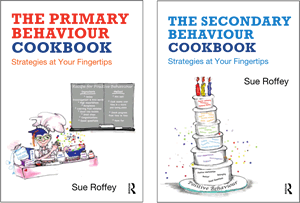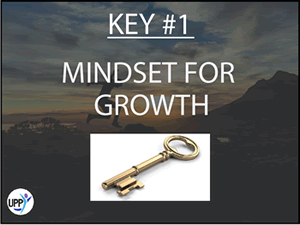 These two companion books, recently published by Routledge, put positive psychology into practice for both everyday issues such as being organised and more challenging behaviours such as unsafe risk taking. The 40 ‘recipes’ in the Primary book and the 50 in the Secondary are placed in categories and preceded by a list of common ‘ingredients’ together with a description of ‘the oven’ – the emotional climate of the classroom. You wouldn’t expect a cake to cook in a cold oven in five minutes so whatever strategy you put in place for behaviour will only be successful if it takes place in a warm, supportive environment and for long enough!
These two companion books, recently published by Routledge, put positive psychology into practice for both everyday issues such as being organised and more challenging behaviours such as unsafe risk taking. The 40 ‘recipes’ in the Primary book and the 50 in the Secondary are placed in categories and preceded by a list of common ‘ingredients’ together with a description of ‘the oven’ – the emotional climate of the classroom. You wouldn’t expect a cake to cook in a cold oven in five minutes so whatever strategy you put in place for behaviour will only be successful if it takes place in a warm, supportive environment and for long enough!
Behaviour guru Bill Rogers endorses the Primary edition saying “…the advice and strategies are immediately enabling and are based in sound psychology as well as teachers’ real experiences…I commend this book….to support respectful, humane and positive behaviour in our schools.
Here are two great excerpts; one from each book; both offering practical and clear advice to support positive classroom behaviours.
Please note that anything starred * is an ingredient from the front of the book
The Primary Behaviour Cookbook – excerpt recipe
The Problem: FREQUENT INTERRUPTIONS
The Recipe: WAITING IN TURN
What you need to know
Learning: Is this a learnt behaviour reinforced by attention – either negative or positive? What happens at home?
Neurological issues: Does the pupil have problems with impulse control and is this consistent with other behaviours?
Patterns: Is there a pattern to the interruptions, e.g. to ask questions, to seek reassurance or to give information?
Context: When is this behaviour least and most challenging and what is happening at these times.
Self-concept: The pupil may think of themselves as not being able to control themselves but they will inevitable have self-control in some situations. Help them identify where and when and raise their pride in this.
Today in the classroom
Clarify expectations at the outset – including what to do if you get stuck.
*Tactical ignoring with attention when it appears that the student has been waiting well. Make a badge or label which says ‘Not Now’ and just tap it without looking at the pupil.
An agreed reminder taped to a desk.
*Proximity praise.
Say ‘Hands up please’.
‘I can’t hear you’ is for students who do not follow procedures such as raising their hand.
Longer term change
Give the student an agreed number of counters per week (or day). These are the number of times they can interrupt to ask a question or make a comment. Once they have used up their counters they will not be answered. You may like to give different colours for questions or giving information. This brings in another dimension to thinking. The number may need to go down as the student learns greater self-control.
Constant interruptions are unfair on others. It is like pushing into the front of a queue.
*Circle Solutions activity:
Give students in threes this situation: Four people were waiting for a bus. As the bus arrived a group of teenagers ran up and jumped on the bus ahead of the queue.
Students consider the following questions and give feedback to the Circle:
- Was this fair or unfair – what are your reasons for saying this?
- What do you think the young people might have been thinking?
- What if they were pushing in in front of someone you knew? How would that make you feel?
- Is someone interrupting all the time like pushing in front of a queue?
- How can we share attention fairly in this class?
The Secondary Behaviour Cookbook – excerpt recipe
The Problem: DESTRUCTIVE BEHAVIOUR (OWN WORK)
The Recipe : VALUING PERSONAL EFFORTS AS WELL AS ACHIEVEMENTS
Students are more likely to value their work if significant adults in their lives also value it.
A student may destroy or damage their own work for the following reasons: They can’t do it; they don’t think it is good enough; it doesn’t have any meaning for them; it is a way of expressing anger with something else. Responses will depend on which.
What you need to know
Context: Does this happen only with certain subjects or with many? Is the pupil pleased with any achievement? What is this?
When: When is the student most volatile? If first thing in the morning they may be upset about something that has happened at home.
Emotions expressed: Is the student angry, distraught, tearful and/or frightened of failing?
Onset and Frequency: Has this begun or got worse recently?
Competitiveness: Does the student compare themselves unfavourably with others?
Learning: Has the student learnt to value only what is perfect?
Ability: Does the student have a literacy problem? Might the level of work need to change?
Other issues: What else might be contributing to or maintaining this behaviour
Today in the classroom
Acknowledge feelings and give space to calm down – model slow, deep breathing.
Maintain a low-key response
Ask the pupil to identify one benchmark for success they could work towards
Discussion of drafts – determine a maximum number – ask student to choose best attempt.
Recall a recent success
Emphasise that everyone is learning and no-one is perfect – Incorporate the *power of yet
Give positive affirmation for effort.
Longer-term change
A whole school acknowledgement that excellence does not mean perfection.
Focus on *growth mind-sets
Communicate with parents/carers about *growth mindsets and the value of praising effort
Clarify *Primary purpose
*Alternative recording
Develop ethos in which mistakes are valued as part of learning
Adults model acceptance of mistakes and constructive criticism.
Involve student in displaying work of their choice
*Personal best ethos
Suggest student writes down what is upsetting them and then destroys this piece of paper.



